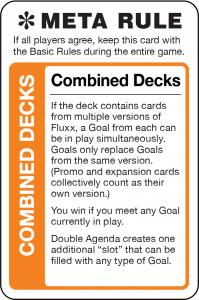…for example, if we wanted to mix two Batman Fluxx decks and there are two BatComputers in play… or even just putting in multiples of a promo card, like the Ugly Sweater. And how should duplicate New Rules be handled?
A: Well it might seem like a basic question but I don’t think we’ve ever really answered it before. The truth is, we prefer each Fluxx as a standalone experience and don’t really encourage combining decks. We certainly don’t recommend combining multiple copies of the same deck. In almost all cases, each card in a Fluxx deck is unique.
Mixing two Batman decks together creates numerous illogical situations. Sure, there’s the question you’ve asked directly, about two BatComputers, but there will also be two Batmans, two Bruce Waynes, etc. Given that you have to discard Bruce if Batman shows up, then it would seem impossible to have two Batmans in play at once as well. And so on. The deck becomes too big to shuffle as well. We just can’t see a good reason to combine two of the same deck — if you want to play with a big crowd, you’re better off splitting into two smaller groups each playing their own game with their own deck.
That said: Nothing is forbidden. Fluxx is a very accommodating system. There’s no rule against having two copies of the same Keeper, unless you add one as a house rule. The Batman/Bruce Wayne restriction is one example of such a rule. So, unless there’s a New Rule or other fine print requiring some action, redundant Keepers can happily co-exist. As for ability stacking, again, barring a New (or Meta) Rule that provides restrictions, each redundant Keeper would have its full ability.
See also When combining decks, how should I treat redundant New Rules?
See also <
